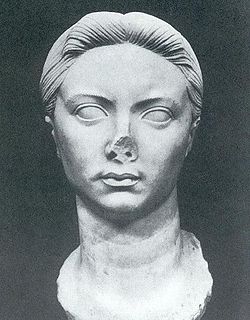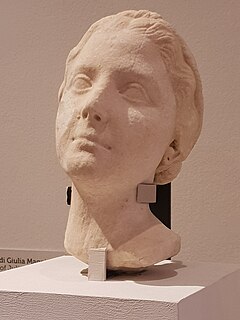
Marcus Vipsanius Agrippa was a Roman general, statesman, and architect who was a close friend, son-in-law, and lieutenant to the Roman emperor Augustus. He was responsible for the construction of some of the most notable buildings in history, including the original Pantheon, and is well-known for his important military victories, notably the Battle of Actium in 31 BC against the forces of Mark Antony and Cleopatra.

Tiberius Caesar Augustus was the second Roman emperor. He reigned from AD 14 until 37, succeeding his stepfather, the first Roman emperor Augustus.
Julia is the nomen of various women of the family Julii Caesares, a branch of the gens Julia, one of the most ancient patrician houses at ancient Rome.

Vipsania Agrippina was the first wife of the Emperor Tiberius. She was the daughter of Marcus Vipsanius Agrippa and Pomponia Caecilia Attica, thus a granddaughter of Titus Pomponius Atticus, the best friend of Cicero.
Vipsania Marcella is a name retrospectively given by historians to a possible daughter or daughters of the ancient Roman general Marcus Vipsanius Agrippa and his second wife Claudia Marcella Major, the eldest niece of emperor Augustus.

Vipsania Julia Agrippina nicknamed Julia Minor and called Julia the Younger by modern historians, was a Roman noblewoman of the Julio-Claudian dynasty. She was emperor Augustus' first granddaughter, being the first daughter and second child of Julia the Elder and her husband Marcus Vipsanius Agrippa. Along with her siblings Julia was raised and educated by her maternal grandfather Augustus and her maternal step-grandmother Livia Drusilla. Just like her siblings she played an important role in the dynastic plans of Augustus, but much like her mother she was disgraced due to infidelity later on in her life.
Lucius Antonius was the son of Iullus Antonius and Claudia Marcella Major.

The Baths of Agrippa was a structure of ancient Rome, in what is now Italy, built by Marcus Vipsanius Agrippa. It was the first of the great thermae constructed in the city, and also the first public bath.

Jeg elsket Tiberius is a 1959 romance novel by Elisabeth Dored. It was first translated into English by Naomi Walford in Great Britain by Methuen and United States by Pantheon Books in 1963 under the name I Loved Tiberius. The novel was written as a careful reappraisal of the contemporary sources, placing Julia and Tiberius in a more positive light. The novel is set in 1st century BC Rome, centred on Julia the Elder, the daughter of Augustus and her life right up until her death. The novel begins with Julia's birth and her mother being forbidden to see her. The plot is mainly focused on Julia's love life, notably her relationship with her stepbrother, Tiberius.

The Gardens of Maecenas, or Horti Maecenatis, constituted the luxurious ancient Roman estate of Gaius Maecenas, an Augustan-era imperial advisor and patron of the arts. The property was among the first in Italy to emulate the style of Persian gardens. The walled villa, buildings, and gardens were located on the Esquiline Hill, atop the agger of the Servian Wall and its adjoining necropolis, as well as near the horti Lamiani.

The Porticus Vipsania was a map of the world once displayed in the Campus Agrippae, located in Rome, not far from the Via Flaminia. It was designed by Marcus Vipsanius Agrippa and constructed by his sister Vipsania Polla after Agrippa died. The map was named either directly after Vipsania Polla or the gens Vipsania, which Polla and her brother Agrippa belonged to.
The Pons Agrippae was an ancient bridge across the River Tiber in Rome. It was located 160 metres above the Ponte Sisto, and is known from an inscribed cippus set up by the curatores riparum during the Principate of the Emperor Claudius, suggesting it was built during or before the reign of Claudius. It was restored in 147 AD. The bridge is named after Marcus Vipsanius Agrippa, a close friend of the Emperor Augustus. Agrippa married Julia, the daughter of Augustus, and the couple lived in a villa on the opposite bank of the River Tiber. To connect his villa to the Field of Mars, where Agrippa had built several important monuments, it has been suggested that Agrippa constructed the Pons Agrippae.

The gens Vipsania was an obscure plebeian family of equestrian rank at ancient Rome. Few members of this gens appear in history, although a number are known from inscriptions. By far the most illustrious of the family was Marcus Vipsanius Agrippa, a close friend and adviser of Augustus, whom the emperor intended to make his heir. After Agrippa died, Augustus adopted his friend's sons, each of whom was considered a possible heir to the Empire, but when each of them died or proved unsuitable, Augustus chose another heir, the future emperor Tiberius.
Vipsania was an ancient Roman noblewoman of the first century BC. She was married to the politician Publius Quinctilius Varus and was a daughter of Roman general Marcus Vipsanius Agrippa and his second wife Claudia Marcella Major.
Vipsania was an ancient Roman noblewoman of the first century BC. She was married to the politician Marcus Aemilius Lepidus and was likely the daughter of Roman general Marcus Vipsanius Agrippa and his second wife Claudia Marcella Major.
Vipsania was an ancient Roman noblewoman of the first century BC. She was married to the orator Quintus Haterius and was likely the daughter of Roman general Marcus Vipsanius Agrippa and his first wife Pomponia Caecilia Attica.
Vipsania was the name of the first wife of Roman emperor Tiberius.

The Regio VII Via Lata is the seventh regio of imperial Rome, under Augustus's administrative reform. Regio VII took its name from the wide urban street the Via Lata. It was the urban section of the Via Flaminia, which ran between the Servian walls and the Aurelian Walls, and corresponds to the modern Via del Corso. The regio contained part of the Campus Martius on the east of the street plus the Collis Hortulorum, the Pincian Hill.










